
Home Use of Respiratory Devices
Breathing is a spontaneous process that continues for life. It is something we often take for granted—until one starts feeling difficulty in breathing. An innumerable number of people worldwide are struggling with chronic respiratory conditions such as asthma, COPD, bronchiectasis, post Tuberculosis, Cystic Fibrosis, Interstitial lung diseases, sleep apnea, and post-COVID lung complications to name a few of them. Once a patient develops these disorders, continuous care and management will be required either at home or when complicated at hospitals. If chronic respiratory conditions are managed effectively at home, it may help reduce hospitalization visits as well as significantly improve the quality of life.
Thankfully, the advancements in medical technologies have resulted in the development of a range of home-use respiratory devices that help monitor oxygen levels, deliver medications, and improve lung function. Using the right equipment at home can make a huge difference in managing a chronic lung disease or recovering from an illness.
The general awareness, as well as acceptance of these types of equipment in-home care, have seen a drastic change during and after the COVID-19 pandemic in patients.
In this guide, we’ll explore a few commonly used respiratory devices at home, their benefits, the correct method of use, and tips on integrating them into your daily routine.
Table of Contents
1. Pulse Oximeter – Your Oxygen Level Monitor
Description:
A commonly used respiratory device in-home care is a portable pulse oximeter. It is a small, clip-like device that works on a replaceable set of batteries. When hooked on the fingertips it measures the oxygen saturation (SpO2) in your blood. It also displays your pulse rate. So, you can judge ‘spo2fithai’ or not by this small device.
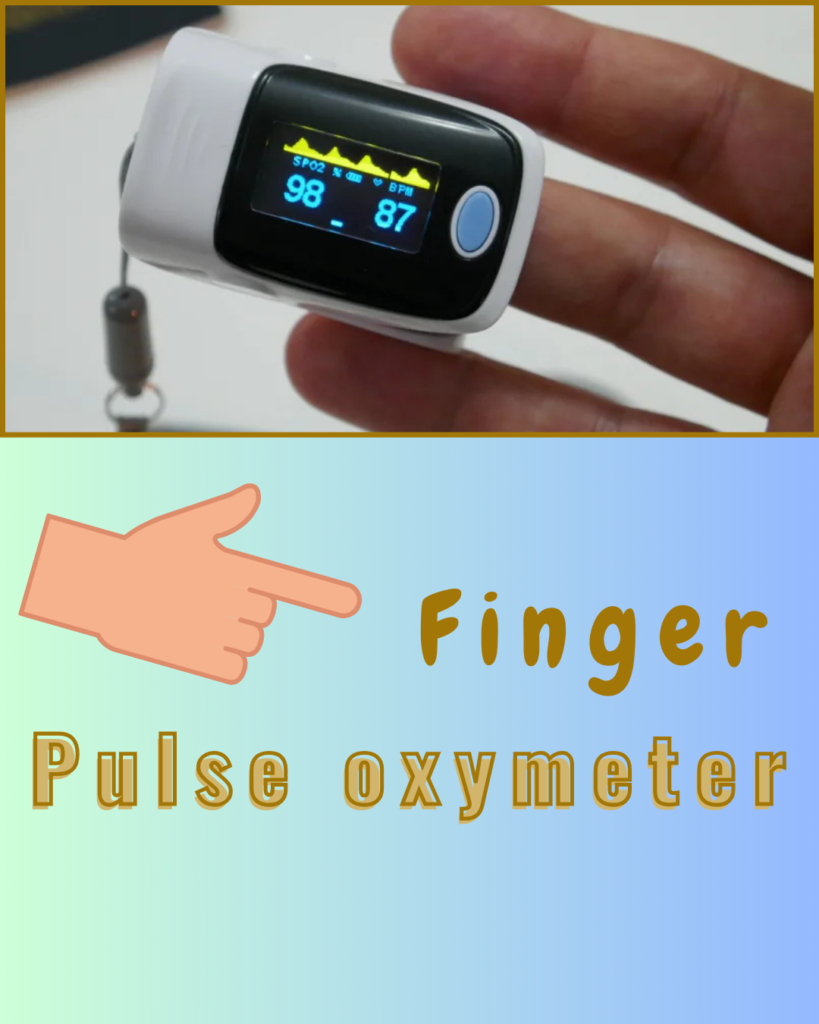
Its Use:
- Portable respiratory devices help track oxygen levels in a variety of respiratory conditions.
- When there is a drop in oxygen saturation (below 90%) it indicates that the person needs urgent medical attention and oxygen therapy needs to be applied (in majority of cases).
- If the device has recording capabilities also, it can be useful for people with sleep apnea to monitor oxygen dips at night.
How to Use It Correctly:
- Place the device on your fingertip, and ensure that it covers your nail bed completely.
- Keep your hand still and wait for a few seconds. The readings shall become stable.
- Depending upon the patient’s need checking oxygen levels multiple times a day may be needed, especially if feeling breathless or fatigued.
Pro Tip: Avoid using the oximeter with cold hands, nail polish, or artificial nails, as they can affect accuracy.
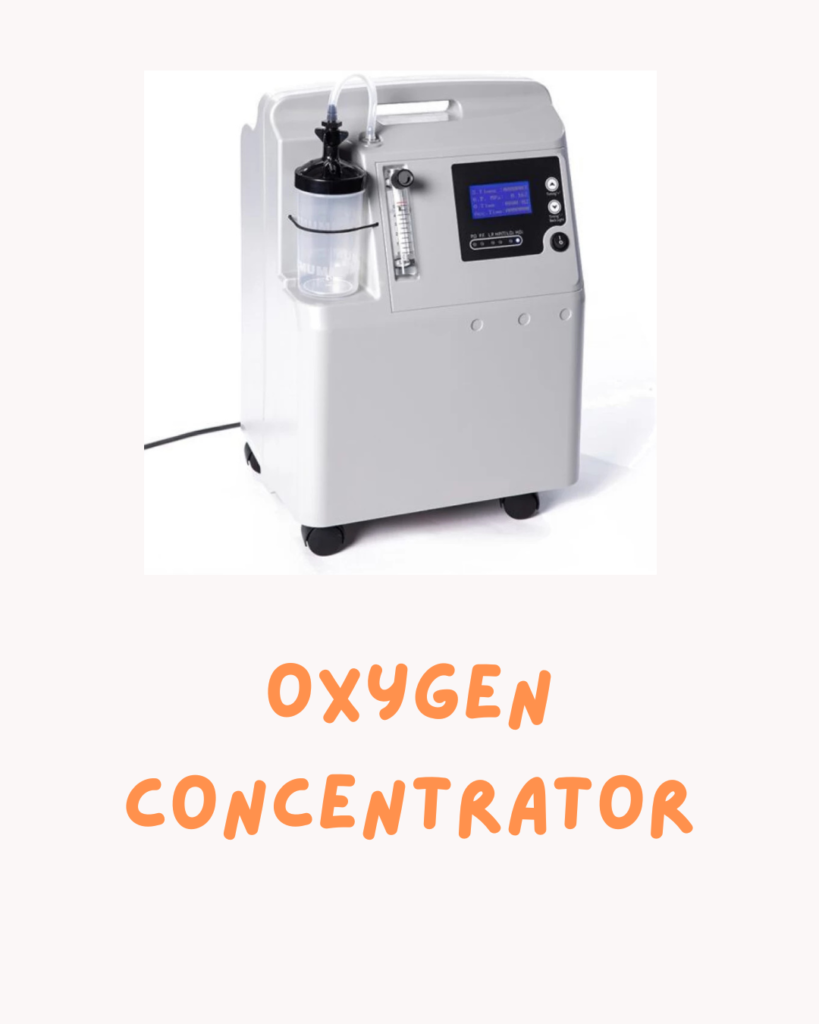
Uses:
- Essential for patients with severe COPD, interstitial lung disease, and post-COVID recovery who are not able to maintain normal spo2 spontaneously.
- Provides a safer, long-term alternative to oxygen cylinders.
2. Oxygen Concentrator – A Reliable Oxygen Supply
Description :
An oxygen concentrator extracts oxygen from the air and delivers it to patients with low blood oxygen levels. There are different types of machines available that can deliver oxygen at a flow rate ranging from 0.5 -10 liters per minute. These Respiratory devices help to deliver oxygen to patients with Chronic respiratory insufficiencies on Long-term oxygen therapy (LTOT)
Safety Tips:
- Use it in a well-ventilated area to avoid oxygen buildup.
- Keep it away from flames (e.g., smoking, candles, stoves).
The equipment should have proper power backup in case of electricity failures.
Pro Tip: Those patients on Long-term oxygen therapy should use this respiratory device for at least more than 16 hours a day.
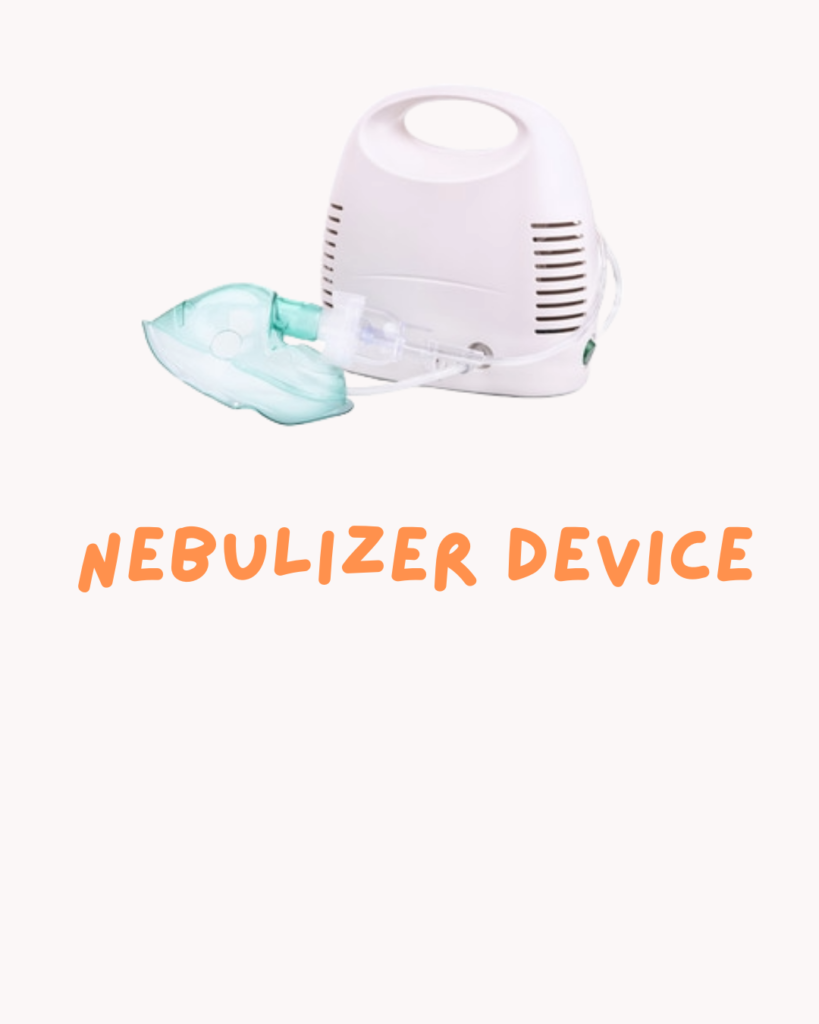
How to Use It Correctly:
- Clean and wipe the nebulization chamber.
- Fill the nebulizer chamber with the prescribed medication.
- Attach the mouthpiece or face mask correctly covering both the nose and face.
- Connect the tubing to the compressor and switch on the power of the nebulizer.
- Breathe deeply through your mouth while keeping a relaxed posture.
- Continue until the mist stops (~10-15 minutes).
3. Nebulizer -A device that makes breathing easier
Description:
Among respiratory devices, previously the use of nebulizers was primarily limited to seriously ill patients at hospitals, but nowadays this small device is being increasingly used for home care and also for patients with chronic respiratory disorders. A nebulizer converts liquid medication into a fine mist, to inhale the medication easily with breath directly into the lungs. Nebulizers available nowadays are either electricity-operated or battery-based.
Its Use:
- Provides quick relief from breathing difficulties in conditions like asthma, bronchitis, and COPD.
- It helps deliver inhalational medicines such as bronchodilators, corticosteroids, and saline solutions. These are various types of medicines that make breathing easier and may help in better functioning of the lungs.
- Those patients who have problems with taking inhalational medicines with other devices, for example, the ‘asthma inhaler’ can also use nebulizers for easy and reliable drug delivery with nebulizers.
Pro Tip: Always clean the nebulizer after each use to prevent bacterial buildup and do not share the common mask & tubing with other patients
4. CPAP/BiPAP Machines – A Lifesaver for Loud snorer’s
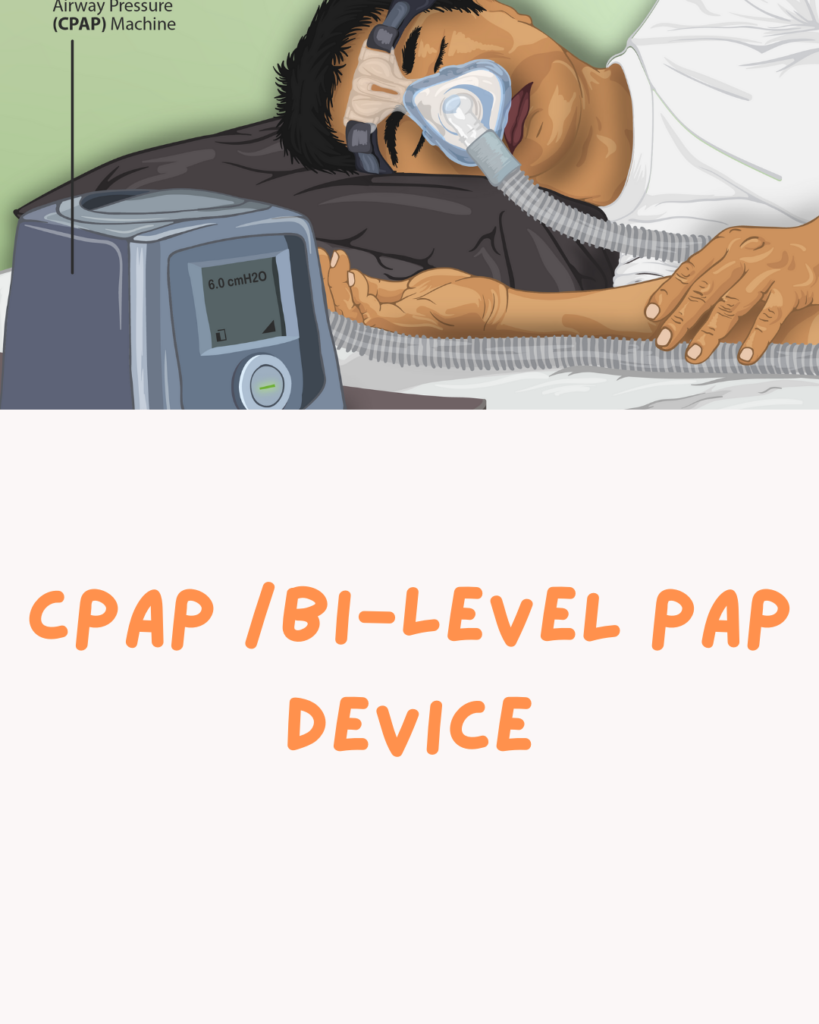
Description:
They are compact respiratory devices that help in ventilating and are also known as non-invasive ventilators. They are used along with the face mask either covering the nose only in nasal masks or both nose and face in full face masks.
- CPAP (Continuous Positive Airway Pressure) device delivers a steady stream of air to keep airways open during sleep.
- BiPAP (Bilevel Positive Airway Pressure) device provides two levels of pressure (inhalation and exhalation) for better breathing control.
Uses:
- Treats sleep apnea, reducing snoring and oxygen drops at night.
- Prevents complications like high blood pressure and heart disease.
- Enhances sleep quality and reduces daytime fatigue.
- Those who have recently recovered from mechanical ventilator therapy
How to Use It Correctly:
- Wear the mask properly over your nose/mouth.
- Adjust air pressure settings as prescribed by your doctor.
- Use it every night for consistent benefits.
🔹 Pro Tip: Keep the mask and tubing clean to avoid infections. A comfortable well-fitted mask is the key factor for proper use of CPAP respiratory devices at home. Hence, before using these respiratory devices, one should take a trial for best best-suited mask at a well-managed center addressing this patient’s need particularly.

How to Use It Correctly:
- Sit upright and hold the spirometer in front of you.
- Inhale deeply through the mouthpiece to raise the indicator.
- Hold your breath for a few seconds, then exhale slowly.
- Repeat 10 times every hour, as advised by a doctor.
🔹 Pro Tip: Pair this with yoga-based breathing exercises(link) like diaphragmatic breathing for maximum benefits.
5. Incentive Spirometer – Gym of your lungs
Description:
An incentive spirometer encourages deep breathing, helping improve lung capacity and prevent lung infections. This respiratory device usually has a mouthpiece for inhaling and has an indicator that shows the depth of breath taken.
Use :
- Beneficial for patients recovering from lung infections, surgery, or prolonged bed rest.
- Helps prevent lung collapse (atelectasis) in postoperative patients.
- Improves lung function in people with asthma, COPD, or post-COVID breathing issues.
- Help prevent pleural peel formation in pleural infections
6. Air Purifier – A Breath of Fresh Air
Description :
An air purifier removes airborne allergens, pollutants, and irritants, ensuring cleaner indoor air.
Uses :
- Essential for people with allergies, asthma, or weak lungs.
- Removes dust, pet dander, smoke, mold spores, and airborne viruses.
- Improves indoor air quality, especially in polluted urban areas.
What to Look For in an Air Purifier:
✔ HEPA Filter: Captures tiny allergens and dust particles.
✔ Activated Carbon Filter: Eliminates odors and toxic gases.
✔ Humidifier Function: Prevents dryness in winter months.
🔹 Pro Tip: Place the purifier in bedrooms and living spaces for optimal air circulation.
7. Breathing Exercise Devices – Natural Lung Strengtheners
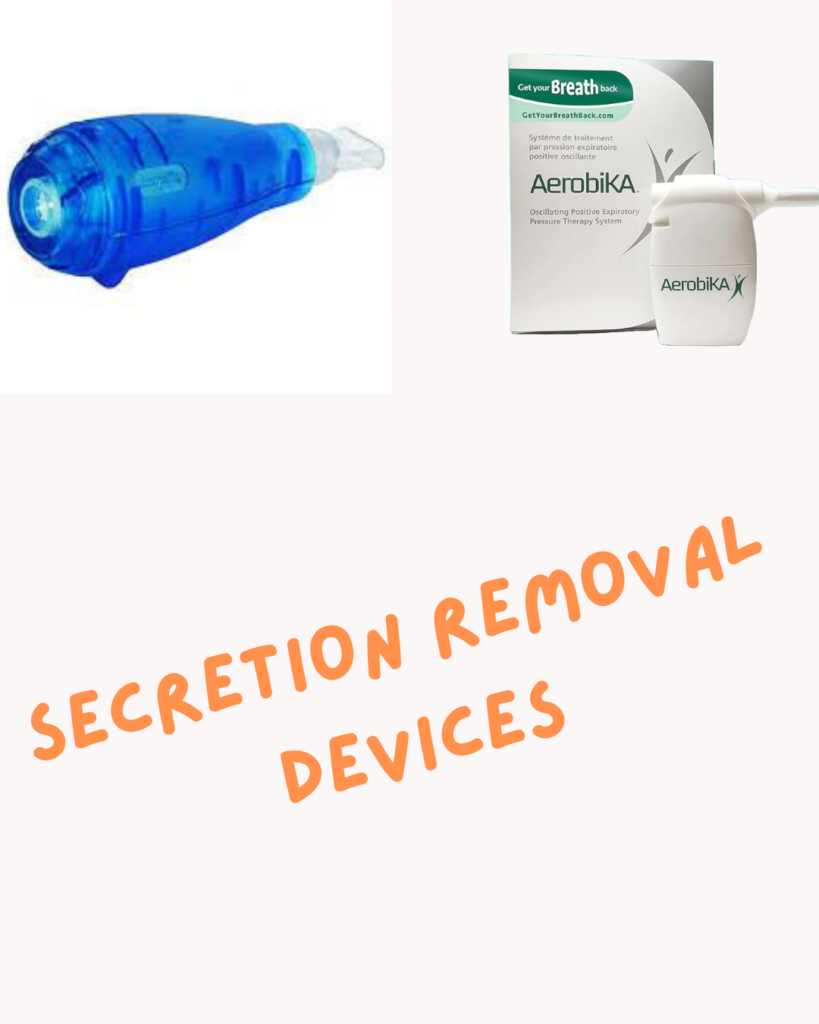
Description:
Devices like Acapella, PEP (Positive Expiratory Pressure) devices such as aerobika and breathing trainers help strengthen respiratory muscles. They are used as portable home-based devices in various chronic respiratory diseases like COPD, Bronchiectasis, etc.
Uses:
- Help with mucus clearance in conditions like bronchiectasis and cystic fibrosis.
- Improve lung endurance for patients recovering from respiratory infections.
How to Use Them Effectively:
- Breathe deeply through the device, then exhale with controlled force.
- Repeat 5-10 times per session, as advised by your doctor.
🔹 Pro Tip: These devices work great alongside yoga-based breathing techniques like Anulom Vilom (alternate nostril breathing) and can be a good companion in a pulmonary rehabilitation program.

How to Use It Correctly:
- Stand or sit upright for an accurate reading.
- Set the meter to zero before starting.
- Take a deep breath, place the mouthpiece in your mouth, and blow out as hard and fast as possible.
- Note the reading and repeat three times, recording the highest value.
Pro Tip: Keep a daily peak flow diary to monitor trends and share it with your doctor for better asthma/COPD management.
8. Peak Flow Meter – A Simple Tool to Track Lung Function
Description:
A peak flow meter is a small, handheld respiratory device that measures how fast you can blow air out of your lungs. It helps monitor lung function and airflow restriction, especially for people with asthma and COPD. With advancements in technology, new features are being added to the device. The devices now are compact, and electronic, some have data-sharing protocols that help link data with the healthcare facility so that in case of deterioration in patient’s day-to-day reading they can send distress calls to your doctor’s clinic or your hospital.
Uses :
- Helps detect early signs of asthma flare-ups before symptoms worsen.
- Allows patients to track their lung function over time and adjust medication if needed.
- Helps identify triggers (e.g., allergens, pollution) that worsen breathing difficulties.
Understanding the Readings:
- Green Zone (80-100% of your normal reading): Breathing is stable.
- Yellow Zone (50-80% of normal reading): Caution—your lungs may be tightening.
- Red Zone (Below 50% of normal reading): Seek medical help immediately!
9. Actigraph – Tracking Sleep Becomes Possible

Description:
Actigraphy is a non-invasive method of monitoring human rest and activity cycles. It is widely used in sleep studies where it can judge the sleep clock and sleep habits. This technique involves wearing a small device called an actigraph, typically on the wrist, to record movement patterns over extended periods. Actigraphy can provide continuous, objective data, that gets recorded in home settings by the device.
An actigraph is a watch-like respiratory device equipped with an accelerometer that detects motion. The recorded movement data is then analyzed using specialized software to infer sleep and wake patterns.
Uses:
Actigraphy has a wide range of applications, including:
- Sleep Medicine: It helps diagnose sleep disorders like insomnia, and sleep rhythm disorders.
- Circadian Rhythm Research: Scientists use actigraphy to study sleep-wake patterns in shift workers, travelers, and individuals with jet lag.
- Mental Health Assessment: This can help monitor sleep disturbances in conditions like depression, bipolar disorder, and anxiety.
- Physical Activity Monitoring: Fitness enthusiasts can use it in fitness tracking and for patients it can be used for rehabilitation to measure activity levels and sedentary behavior.
Advantages of Actigraphy
- Non-Invasive and Comfortable:
- Long-Term Monitoring possible
- Cost-effective in certain circumstances
- Ecological Validity: the data is collected in naturalistic settings(home), making it more representative of real-life behaviors.
But actigraph is used as a diagnostic/monitoring device in contrast to other above-mentioned home respiratory devices used in patient treatments.
Protips: The data collected may not be very accurate, so clinical assessment/correlations must be done by a medical expert.
10 Smart Watches: Be smart with your health
In recent years, smartwatches have revolutionized personal health monitoring by integrating advanced sensors that track various physiological parameters. These devices, while primarily designed for everyday wear, offer functionalities similar to home actigraphy devices and extend their capabilities beyond sleep tracking.
These smartwatches can help track many parameters:
- Sleep parameters – here they function as similar to actigraph in assessing the sleep patterns
- Heart rate monitoring
- Spo2 monitoring is also available on some smartwatches that can track blood oxygen levels as respiratory devices.
- Activity parameters useful for the assessment of fitness, like step counts, calorie consumption, and distance walked are recorded by the device. They can perform,6 minutes walk test, which is an important assessment method in respiratory practice.
Limitation: These devices may not be very accurate in measuring the above parameters, but can be conveniently used for health screening. They offer the advantage of measuring multiple parameters in addition to the simple watch functions.
Conclusion: Empowering Yourself with the Right Tools
Managing respiratory conditions at home becomes much easier with the right equipment. Whether it’s monitoring oxygen levels, improving lung function, or ensuring cleaner air, these respiratory devices provide a lifeline for better breathing.
However, always consult a doctor before using any medical equipment. Learn the tricks and intricacies of these devices from your therapist before actually using them to get the most benefit and remember—combining the right tools with correct breathing exercises and pulmonary rehabilitation can enhance their effectiveness even further!
